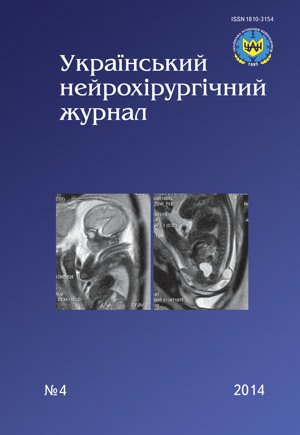Dependence of plasminogen activator inhibitor-1 level on -675 4G/5G polymorphism in PAI-1 gene in patients with traumatic brain injury
DOI:
https://doi.org/10.25305/unj.46604Keywords:
traumatic brain injury, plasminogen activator inhibitor-1, -675 4G/5G polymorphism of PAI-1 geneAbstract
The purpose. To study relationship between plasminogen activator inhibitor-1 (PAI-1) level in plasma and -675 4G/5G polymorphism in the PAI-1 gene in patients with traumatic brain injury (TBI) in dynamics of treatment.
Materials and methods. The state of hemostasis in 200 patients with TBI was analyzed by means of studying relationship between PAI-1 level in plasma and -675 4G/5G polymorphism in the PAI-1 gene.
Results. Correlation between PAI-1 level increasing and 4G/4G and 4G/5G genotype in patients was shown. PAI-1 level increasing in dynamics of treatment was found in patients with 4G/4G and 4G/5G genotypes.
Conclusions. The relationship between -675 4G/5G polymorphism in the PAI-1 gene and PAI-1 level in plasma in patients with TBI was proved.
References
Bruns J, Hauser W. The Epidemiology of Traumatic Brain Injury: A Review. Epilepsia. 2003;44:2-10. CrossRef
Huk AP. [Traumatic brain injury epidemiology in Ukraine]. In: Abstracts Book of the V Congress of Neurosurgeons of Ukraine; 2013 June 25–28;Uzhorod, Ukraine. Uzhorod, 2013. p.30. Ukrainian.
Genét G, Johansson P, Meyer M et al. Trauma-Induced Coagulopathy: Standard Coagulation Tests, Biomarkers of Coagulopathy, and Endothelial Damage in Patients with Traumatic Brain Injury. Journal of Neurotrauma. 2013;30(4):301-306. CrossRef
Kozlov A, Berkovskyy A, Prostakova T et al. Klynycheskaya y laboratornaya dyahnostyka naybolee chasto vstrechayushchykhsya narushenyy hemostaza. Moscow: RENAM; 2010. Russian.
Lekhan VM, Huk AP. [Specifics of traumatic brain injury epidemiology in Ukraine]. Ukraine. Zdorovya Natsiyi. 2010;(2):7–14. Ukrainian.
Huq MA, Takeyama N, Harada M, Miki Y, Takeuchi A, Inoue S, Nakagawa T, Kanou H, Hirakawa A, Noguchi H. 4G/5G Polymorphism of the plasminogen activator inhibitor-1 gene is associated with multiple organ dysfunction in critically ill patients. Acta Haematol. 2012;127(2):72-80. CrossRef PubMed
Dellas C, Loskutoff D. Historical analysis of PAI-1 from its discovery to its potential role in cell motility and disease. Thromb Haemost. 2005. CrossRef
Tsantes A, Nikolopoulos G, Bagos P, Bonovas S, Kopterides P, Vaiopoulos G. The effect of the plasminogen activator inhibitor-1 4G/5G polymorphism on the thrombotic risk. Thrombosis Research. 2008;122(6):736-742. CrossRef
Asselbergs FW, Williams SM, Hebert PR, Coffey CS, Hillege HL, Navis G, Vaughan DE, van Gilst WH, Moore JH. The gender-specific role of polymorphisms from the fibrinolytic, renin-angiotensin, and bradykinin systems in determining plasma t-PA and PAI-1 levels. Thromb Haemost. 2006;96(4):471-477. PubMed
Ozolina A, Strike E, Jaunalksne I, Serova J, Romanova T, Zake LN, Sabelnikovs O, Vanags I. Influence of PAI-1 gene promoter-675 (4G/5G) polymorphism on fibrinolytic activity after cardiac surgery employing cardiopulmonary bypass. Medicina (Kaunas). 2012;48(10):515-20. PubMed
Rebrova O. Statystycheskyy analyz medytsynskykh dannykh. Prymenenye paketa prykladnykh prohramm Statistica. Moscow: Mediasfera; 2008. Russian.
Downloads
Published
How to Cite
Issue
Section
License
Copyright (c) 2014 Oleksandr Potapov Jr, Oleksii Kmyta

This work is licensed under a Creative Commons Attribution 4.0 International License.
Ukrainian Neurosurgical Journal abides by the CREATIVE COMMONS copyright rights and permissions for open access journals.
Authors, who are published in this Journal, agree to the following conditions:
1. The authors reserve the right to authorship of the work and pass the first publication right of this work to the Journal under the terms of Creative Commons Attribution License, which allows others to freely distribute the published research with the obligatory reference to the authors of the original work and the first publication of the work in this Journal.
2. The authors have the right to conclude separate supplement agreements that relate to non-exclusive work distribution in the form of which it has been published by the Journal (for example, to upload the work to the online storage of the Journal or publish it as part of a monograph), provided that the reference to the first publication of the work in this Journal is included.









